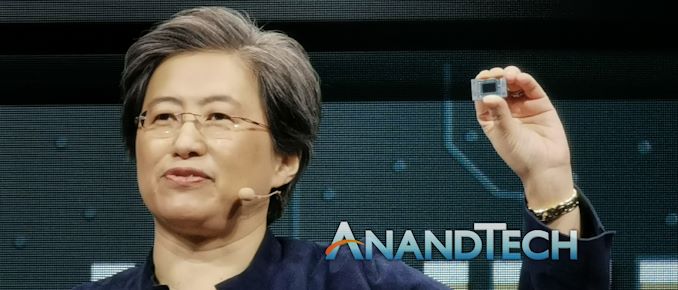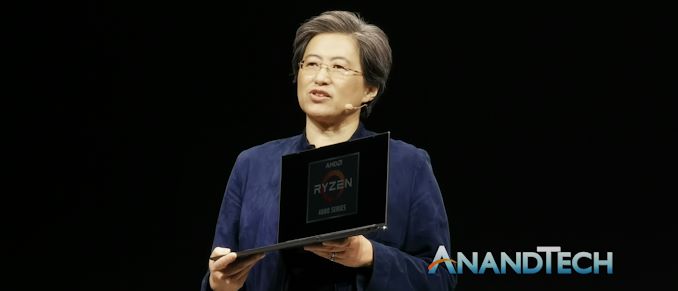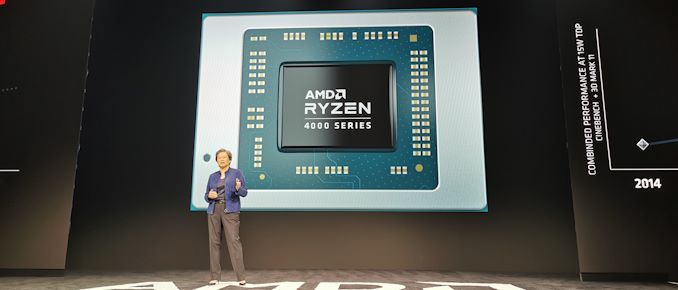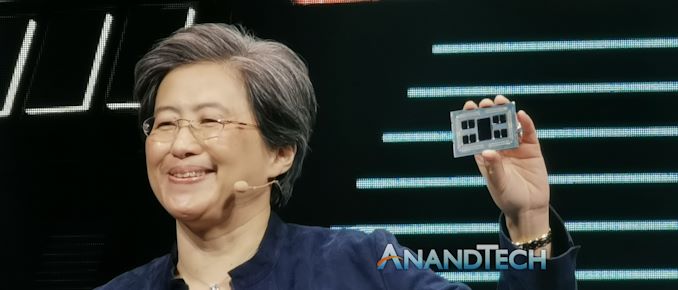AMD at CES 2020: Q&A with Dr. Lisa Su
by Dr. Ian Cutress on January 7, 2020 12:15 PM EST- Posted in
- CPUs
- AMD
- GPUs
- Trade Shows
- Interview
- Vega
- Navi
- Ryzen
- Ryzen Mobile
- Zen 3
- Renoir
- CES 2020
- Ryzen 4000

This week AMD took the wraps off of its latest generation of mobile processors. The company is being aggressive, offering up to eight cores for both the traditional ultra-portable notebook as well as the higher-performance content creator and prosumer notebook. The move to 7nm, as well as design efficiency improvements, have been quite aggressive, with the new hardware claiming double the performance per watt, 20% lower SoC power, and 80% quicker adjustments from low-to-high power inside the chip. This has enabled some key design wins, as seen at CES this week, which are set to come out over the next year.
As part of the CES announcements, AMD invited a small number of press to talk to the CEO Dr. Lisa Su about the announcements, 7nm, mobile, and for any other lingering questions about AMD’s recent position in technology news. Here was our chance to tackle AMD’s stance about what it thinks about the future of the mobile space, and where these new products fit into that ecosystem where the company has not traditionally performed so well. With the opportunity at hand, Dr. Su was very keen to discuss how AMD has worked with its partners to enable what it sees as high-performance hardware that users can tangibly feel offer them a differentiated experience.
The format was for a general roundtable Q&A, and so the transcription below has been adjusted so questions that align are listed consecutively.
Renoir Design Timeline
Dr. Ian Cutress, AnandTech: These chips would have been in the design phase three years ago - has the laptop market changed since those initial design plans from where it was at that time?
LS: That’s a good question. I would say that there is more desire for performance in any given form factor. That’s where we’re doing this H-series, what we’re doing around gaming and content creation and offering more TDP but a lot more horsepower. I think Frank (Azor) said it very well – the idea of briging desktop class performance into the notebook form factor is one of the fastest growing areas in the market. We didn’t spend a lot of time on our commercial plans and designs today, but you can expect that our commercial offerings will be very important. Part of that is bringing security and manageability to the platform – businesses want more control over their machines.
Volker Rißka, ComputerBase: If the design was being discussed three years ago, why are the new parts using Vega, and not Navi?
LS: It's always how we integrate the components at the right time. Certainly the Vega architecture is well known, very well optimized. It was always planned that this would be Zen2 + Vega. But just to be clear, you will see Navi in our APUs, and those will be coming.
Graphics
AnandTech: One of Intel’s marketing points has been that in order to get the best graphics in a laptop, such as the RTX 2080 and above, is to get an Intel laptop. Can you say if any of your OEM partners are going to partner the new Ryzen Mobile hardware with the best in the graphics market?
LS: As you can imagine, I’m not going to preannounce designs from our OEM partners, but I would say that you should believe that we are on a clear mission, and that mission is to have AMD in more premium designs for both the consumer and commercial markets. That’s not just our focus today, in 2020, but beyond 2020 also.
Dean Takahashi, VentureBeat: Is real time ray-tracing in graphics going to be as big as NVIDIA says it is?
LS: I’ve said in the past that ray tracing is important, and I still believe that, but if you look at where we are today it is still very early. We are investing heavily in ray tracing and investing heavily in the ecosystem around it – both of our console partners have also said that they are using ray tracing. You should expect that our discrete graphics as we go through 2020 will also have ray tracing. I do believe though it is still very early, and the ecosystem needs to develop. We need more games and more software and more applications to take advantage of it. At AMD, we feel very good about our position on ray tracing.
AnandTech: The rearchitect of Vega for 7nm has been given a +56% performance increase. Does this mean that there was a lot left on the table with the design for 14/12nm? I’m trying to understand how you were able to pull so much extra performance from a simple process node change.
LS: When we put Vega into a mobile form factor with Ryzen 4000, we learned a lot about power optimization. 7nm was a part of it sure, but it was also a very power optimized design of that architecture. The really good thing about that is that what we learned is all applicable to Navi as well. David’s team put a huge focus on performance per watt, and that really comes out of the mobile form factor, and so I’m pleased with what they are doing. You will see a lot of that technology will also impact when you see Navi in a mobile form factor as well.
AnandTech: Normally when you go after efficiency, there’s not always a positive correlation on frequency, but somehow you’re able to drive higher frequencies on the Mobile APUs on 7nm. Is there a special sauce?
LS: A lot of hard work has gone into this design!
Gordon Ung, PC World: Do you think that AMD has to have a high-end competitor in the discrete graphics market?
LS: [laughs] I know those on Reddit want a high end Navi! You should expect that we will have a high-end Navi, and that it is important to have it. The discrete graphics market, especially at the high end, is very important to us. So you should expect that we will have a high-end Navi, although I don’t usually comment on unannounced products.
How To Out-Intel Intel
PC World: Breaking into desktop was relatively easy for AMD. For laptops, Intel has been circling the wagons for a while, so what are some of the challenges for AMD in this space? Can you address Thunderbolt 3 and CNVi-based Wi-Fi 6?
LS: We've always thought it would be a deliberate rollout of technology. So with desktops and servers all about the CPU and took advantage of chiplet technology. As you go into the notebook form factor, we’ve integrated the CPU and the GPU and we’re pushing boundaries on battery life. We think the Ryzen Mobile 4000 series is going to be a very, very strong part for us. Very strong. If you look over the last eight quarters, we’ve gained share in the PC market, for every single quarter. We believe that with the Third Gen Ryzen Mobile we will take that market share to the next level with notebooks.
I think we’re very bullish on what we can do, and it’s not just what we do, it’s what we can do with our OEMs. If you were to spend time with any of the OEMs I think you can also see that they’re doing a lot more designs in the AMD ecosystem, so we feel really good. We presented a couple of designs today with the Lenovo Slim 7 as well as the ASUS Zephyrus G14. There are a lot more machines coming out, in very nice form factors, all using the full power of the Ryzen 4000 series.
VentureBeat: How does AMD make headway in commercial client market against Intel?
LS: It's all a journey. What we have seen is the PC market is a good market, and if you see just how many PCs are sold, desktops and notebooks, we have made a lot of progress. Today there are a lot more products out with AMD inside, whether you look at large retailers or commercial manufacturers that are starting to incorporate AMD. I’m very optimizisic about what we can do, and of course bringing our notebooks into 7nm will certainly help build on our progress made with 2nd Gen Ryzen Mobile, but the 3rd Gen Ryzen Mobile will certainly help.
AnandTech: Intel is a bigger company, and MDF (Marketing Development Funds) is a big tool in Intel’s arsenal. While having nice designs and design wins for AMD, from a marketing perspective, how do you compete against that?
A: This is about bringing great technology to market but also having an ecosystem behind it. What I’ve learned is that success begets success, and so when we moved from 1st Gen Ryzen Mobile to 2nd Gen Ryzen Mobile, you saw significantly more designs in the market – I think we’ve probably had over 50 designs in the last year. OEMs are starting to understand the capabilities of our technology and we’ve been very very consistent with our roadmaps, and so you can imagine how important it is when we say there will be over 100 notebook designs with Ryzen Mobile 4000 in 2020 – there’s just a wider set of designs to now choose from. And yes, there is MDF involved, and there’s a whole retail marketing chain there, but I think our brand is doing pretty well, and we will continue to invest in the brand and invest in the ecosystem that will help promote AMD.
PC World: Intel has put a lot of money into its mobile technologies, such as the one watt display panels, and is working very deep with the ecosystem and vendors that provide a lot of that optimized functionality. Is AMD also going to have to spend a similar amount of money to compete with the ecosystem that Intel has built, because it feels like there’s a lot still to do that Intel has a lead on.
LS: The way to think about it is that the technology is key. The performance of Ryzen Mobile is significant – we are working with the ecosystem to how we optimize for panels and other parts, because that’s how we do things. But I think the ecosystem is also changing, and this idea that one person or one company is going to define what the next generation of laptops is going to look like, I just don’t think that’s going to be the case. If you look at what Microsoft is doing, or what Dell or HP are doing, they all have their own ideas about what the next generation form factor will look like. For AMD, we’re going after the volume areas of the market, so from that standpoint it’s the fact that we’re moving Ryzen Mobile up the stack and introducing Ryzen 4000 to ultra-thin devices up to H-series and commercial which is important to us. I think we have lots of opportunity to grow.
VentureBeat: Intel has a shot at getting its act together on manufacturing and becoming more of a threat. Any comment?
LS: You’ll have to ask Intel about their technology. But from our point of view, we never build a roadmap without expecting others to meet their roadmap. We've executed our roadmap from the previous five years and we’re extending it into the next 5 years, all while assuming our competition will be competitive and even beating their public targets. I think we’ve made some good choices, and this market is all about making the right choices at the right time, such as when you bring certain elements of technology to market in which order and how that is achieved. We need to continue executing on our cadence, and that has been one of our strengths. I’m expecting to have very stiff competition, whether you’re talking about process technology, microarchitecture, or packaging technologies. I’m also expecting us to do quite well, because that’s our job.
PC World: Do you think you have to compete with Intel on their new foldable devices and other form factors that they’ve started pushing through lower power parts [like Lakefield]?
LS: What you will see is that we will continue to push the envelope on form factor. We are working very closely with Microsoft on some of the features and functions that are required to enable those types of form factors. I think you can see what some of the work that we did with Surface, such as a sleek design, and we’ll see more of this going forward. The idea at AMD is that we know what we’re good at, and we’re really good at ensuring that we have differentiated performance, and that’s our focus when working together with OEMs. They’ll put these sorts of feature sets into differentiated designs and I think that’s really important to have unique designs based on AMD silicon.
AMD’s Brand
VentureBeat: There is a lot of discussion about how products like Threadripper have affected the market and the brand. How is the brand changing?
LS: It’s not always clear cut just looking at one product and saying how the brand is changing – I mean we have a specific amount of market share but across Ryzen on the desktop, on the notebook, as well as Threadripper, there’s a lot more recognition of AMD and we always see new form factors for our hardware across all segments. Like I said, success begets success. If you think about what we did in desktop, 1st Gen Ryzen was good, 2nd Gen Ryzen was better, and now you look at 3rd Gen Ryzen today, if you go to Amazon, AMD has 12 out of the top 12 best-selling desktop processors. That is tangible change. I think you’re going to see that on the notebook side as well – we’ve seen very very good sales through our partners as we’ve gone into the holiday season, and that’s only on the Ryzen 3000 series. I think we’re excited about what the Ryzen Mobile 4000 series will do in 2020.
PC World: AMD has had the leadership in premium gaming desktops in the past, but is this is the first time that AMD will offer sizable competition in premium laptop designs?
LS: This is a big foray into laptops – we are putting a lot of wood behind the arrow. I think we’ve had some good key designs in laptops in the past, but historically these have been at the low end of the market. What you’re going to see is a broader range of designs, of technology, and it’s because the products are really really good. We believe that Ryzen Mobile 4000 series are the best notebook processors available today, and we have some great OEM partners building some great machines.
TSMC and Wafer Supply
AnandTech: Since the launch of 7nm, AMD has had a large demand and we’ve noticed AMD have trouble keeping some of its product in stock. There have also been stories about TSMC and lead times increasing, and we recently had a quote from CTO Mark Papermaster about the ability to predict at any given time how many wafers are needed. Can you speak about how AMD will approach its partnership and its orders with TSMC through 2020?
LS: Today on stage I mentioned that we now have 20 products built on 7nm, either in production or in development, so we have bet big on TSMC’s 7nm process. We have great relationship with TSMC – they’ve supported us well, but wafer supply is tight. From our standpoint, we need to ensure that we get that prediction of what the demand will be early. In our desktop lines, when we first launched 3rd Gen Ryzen, there were some areas where we were out of stock at the high-end, particularly on the 3900X and 3950X. Now you’ll see that those CPUs are readily available, through the retailers. So it’s just a matter of when you are early in the cycle, making sure that you can call it correctly. That being the case, I think the technology is working really well, and we’re pleased with how 7nm has ramped for us.
AT: Just to confirm, you said that wafer situation at TSMC was tight, or right?
LS: Tight.
AnandTech: To go beyond that, AMD has already spoken about how its Zen 3 products will be built on TSMC’s N7+. Does that help alleviate the situation, given how parts of your product portfolio will transition to a slightly different process?
A: It’s fair to say that all the variants of TSMC’s 7nm share a lot of technology between them, whether that’s N7, N7P, or N7+. The main thing is that we forecast well and plan for success. That's what we're doing.
On The Desktop: APUs and Threadripper
VentureBeat: With the launch of Renoir-based Ryzen Mobile 4000 APUs, where is AMD on the desktop APU variants?
LS: It's a little bit early. When you take a look at our portfolio, we were very focused in 2019 about the desktop market and the server markets, and we also launched our first Navi-based chips with RDNA. I think going into 2020, well many of you have asked me about Zen 2 coming to notebooks. So we’re very excited about Renoir, the Ryzen Mobile 4000 series, and you should expect a lot more from is. It’s only January in 2020, so there’s a lot more to go.
PC World: With Threadripper now at 64 cores, is there a limit to how far you can push the core count for consumers?
LS: Is there a limit? [laughs] I think that for 3rd Gen Threadripper, 64 is the current limit! You might have seen in some of the data, that when you go from 16 to 32 cores, the scaling is actually quite good. For multithreaded applications, moving up to 64 there can be a bit of overhead and you won’t see perfect scaling. We believe that it will get better with optimization. Today there’s a lot of professional people that do not realize what you can do with 64 cores, so right now we’re working with the ecosystem to make sure that they’re able to really utilize all of these cores. We love seeing new applications, and we love working with the users that can really take advantage of it – we’re really trying to optimize those capabilities.
Bullish on Arm and RISC-V
AnandTech: AMD have previously had Arm based products, such as with Seattle, and the K12 project. Arm has put forward a roadmap for its leading enterprise cores to deliver performance gains of 25% year on year, which goes beyond AMD’s ‘above market’ target of 7%. Is there a time where AMD would look into doing a high-performance Arm design?
LS: So we already work with Arm in some of our microcontrollers on our designs and products. From a server standpoint, we are not investing in Arm at this point. We think that there’s a huge market out there for x86. I do think Arm has a market and capability, but from our standpoint the focus on x86 is the right thing to do. There’s a lot more we can do in the datacenter, and we have plans to stay with x86 and our EPYC portfolio, going from 2nd Gen EPYC and beyond.
VentureBeat: Looking at the whole industry, what do you think of RISC-V as a challenger to the way of doing things?
LS: There will be those that use it, and they've seen some good momentum. Our focus is very clear, it’s all about high-performance compute, and for that x86 is the leader.
Zen 3
AnandTech: AMD’s products have been on a very regular 12-14 month cadence for the last three years. Should we expect to see Zen 3 this year? In previous CES presentations you’ve shared 12-month roadmaps, but this year you only spoke about Q1 and Q2. Would you like to comment on Zen 3 or what’s coming?
LS: You should expect that we’re going to be very aggressive with the CPU roadmap. We think Zen 2 is the best CPU core out there today, and we’re very proud of it. We’ve completed the family and Zen 3 is doing really well, we’re very pleased about it and you’ll hear more about it in 2020. Rather than ask me the question three times Ian [laughs], let me clear: you will see Zen 3 in 2020!
Many thanks to Lisa and her team for their time.














93 Comments
View All Comments
Threska - Tuesday, January 7, 2020 - link
The "Osborne effect".WaltC - Wednesday, January 8, 2020 - link
I didn't see anything opaque or oblique in the following quote:"Rather than ask me the question three times Ian [laughs], let me clear: you will see Zen 3 in 2020!"
Last sentence--I think some people were skimming instead of reading...;)
lightsout565 - Tuesday, January 7, 2020 - link
Great read!Small typo --
PC World: With Threadripper now at 64 cores, is there a limit to how far you can push the core count for consumers?
LS: Is there a limit? [launchs]
Threska - Tuesday, January 7, 2020 - link
Memory bandwidth per a core might become an issue.extide - Wednesday, January 8, 2020 - link
wooooshianisiam - Wednesday, January 8, 2020 - link
That one made me laugh because I read it as "launches" and imagined her suddenly blasting off like a rocket.MikeSmith007 - Tuesday, January 7, 2020 - link
Dear Ian,The next time you get to meet our wonderful and beloved AMD folks, Dr. Su and Mr. Papermaster, maybe you could ask them a simple question: Why doesn't AMD release their PRO Ryzen chips to Enthusiast-Consumer (EC) market? Let's all come to face with the truth - manufacturers like Lenovo and HP are pairing up AMD's best silicon with some of the most sub-par components on the market, just look at the teardown videos of their desktops, you will see how cheap the components are on their motherboards. Pairing an AMD Ryzen PRO chip with a Lenovo/HP motherboard is like putting a Ferrari engine into a Hyundai frame, what is the point?
Being both a pro user and business owner, the quality and security features of my hardware choices is not just important, it is Paramount. Personally, I would choose and AMD Ryzen PRO chip over a regular Ryzen, anytime, because I run a single workstation with several VMs on it for both personal and business use. So in my true and honest opinion, AMD highly underestimates the value of offering their PRO line chips to the consumer enthusiast market, and in doing so, is also cutting their own profits. Hopefully in 2020 AMD gets to "Ryzen" to an enlightening idea of offering their PRO line chips to a wider audience.
Sincerely
MikeSmith007 - Tuesday, January 7, 2020 - link
"To be truly successful, one must also be open-minded"FreckledTrout - Tuesday, January 7, 2020 - link
They asked this in a bout the only way possible. Obviously AMD knows and the way Lisa responded they fully intend to make sure this improves.Topweasel - Tuesday, January 7, 2020 - link
Ryzen pro is just their more OEM focused SKU's (65w and lower) with software and bios support packages for enterprise features (like encrypted memory, and remote access like Vpro). Not really any better. Things like Asus with the 35w H's and the Surface Laptop Ryzen's are the only chips with truly better silicon and when a company is paying for their own sku, its not going in bargain basement product.